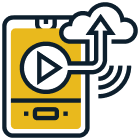
10 Tips And Tricks To Improve Student Engagement
Jul 19, 202114 mins read
Student engagement accelerates an inspiring assemblage of student outcomes, whether learning occurs in brick-and-mortar schools or virtual environments on videos utilizing subtitles in educational content. However, a room full of unruly children can be pretty intimidating to both new and experienced teachers. Fortunately, teachers determine efficient systems of engaging children whether they are trained in a bachelor’s degree or alternative certificate curriculum. Even if you’ve stayed in the classroom for several years, it can help to get back to the basics now and again, particularly with the use of subtitles in educational content.
The days when students arranged into a classroom, met at personal desks, and listened to a teacher talk from behind a podium are a matter of the past. Now, manageable learning settings and classrooms offer more possibilities for students to practice 21st-century abilities like critical thinking, collaboration, and teamwork.
What Is The Concept Of Student Engagement?
Student engagement is an idea often presented in education, and affluence of research exists on the topic. Therefore, student engagement is something teachers aspire to notice and hold in their classrooms. Usually, student engagement leads to be viewed as the level of concern students display towards the topic being taught; their interplay with the content, instructor, and peers, and their impulse to study and advance over the progression.
Online learning confers new challenges compared to a conventional classroom because students are segregated from their teacher by a computer screen. How can we involve our learners in the content, learning exercises, and evaluations? How can we stop responses of disappointment or isolation and maintain them motivated? Online instructors often ask these questions to maintain the same levels of engagement they see and feel in their face-to-face classrooms.
The Emergence Of Distant Learning
The current situation due to COVID has forced schools, universities, and other educational institutions to adjust to remote learning. For example, UNESCO reports that school closures have swayed 90% of the world’s student population in light of the global pandemic. So now, instead of meeting in person and having classes face-to-face, teachers and students have to accommodate a remote setup to advance their education.
While the shift to this different method is stimulating for educators like subtitles in educational content, it is all the more challenging for students. Several of them are used to learning inside the four walls of a classroom, and having to shift to a fully online environment may influence motivation and on-task performance.

Here are some ideas about how educators can encourage students to remain committed, motivated, and enthusiastically learning:
1. Design a welcoming atmosphere
Whether students are getting guidance in person or online, or a hybrid, they are more prone to interest in training if they feel welcome and understand that teachers are genuinely invested in their learning and growth. Addressing each student with a smile and praising them for showing up is more essential than ever. As we know for several students, the school day now incorporates very real physical boundaries such as face masks and plastic dividers in classrooms or, in the event of online instruction, having to communicate by a screen.
2. Concentrate on Active Learning
Engagement procedures are efficient when they are based on learning principles that emphasize active learning. When educators concentrate on arranging students to “do” something, the effects are often effective rather than “learn” something. Instead, have students get cognitively or physically active. Develop activities in which they cooperate in group assignments, resolve problems together or individually, or become immersed in experiential learning projects, including dialogue and shared research. Performances, debates, “pop” speeches, and games are all teaching strategies that emphasize active student application over passive instructor-led presentations.
It is vital to put in mind that active learning exercises reward extroverts, while introverts may suffer. Furthermore, impressions can be deceiving, as students who listen and get notes are actually engaged, often more than the extroverts who ring in intermittently.
3. Foster Goal-Setting, Competition, and Failure
Incentivize students to build their own purposes for the course and develop personal milestones to indicate their own progress. It carries the ownership of action from the instructor to the student by making the student interested and motivated. If the student aspires to achieve expertise or even a high grade, the best route will be one that he or she represents.
With every student’s goals established, the next plausible step is generating healthy competition and not comparing students and themselves. Who can reach the milestones most immediately? How fast can the student achieve the next milestone? In what ways can the student fix a personal best and then hit it the next time around? This method also serves to take some of the student’s center off grades; giving it about studying results for the student heightens interest and engagement.
Ultimately, construct situations in which failure is a true possibility. The academic context should be seen as an incubator for approaches, experiments, and the required learning possibilities that failure provides — without the more critical outcomes of real-world failure.

4. Utilize the Community of Inquiry (CoI) Model in Online Discussions
Researcher Randy Garrison contracted the established CoI model for maximizing engagement in online exchanges. Its goal is to build a social and teaching behavior foundation to stimulate cognitive presence in a course. Here is what the terms imply, according to Purdue University’s CoI framework.
- Cognitive behavior: The degree to which students can create and establish meaning by supported reflection and discussion.
- Social behavior: The capacity to observe others in an online environment as “real” and the rim of oneself as a real person. It comprises open communication, effective eloquence, and group coherence.
- Teaching behavior: The plan, facilitation, and regulation of cognitive and social rules to realize significant learning. It includes instructional design, facilitation, and straightforward instruction. Students themselves must have an educational presence in the community, which is gained through a consideration of their own questions.
5. Established Clear Expectations
Too much complexity in commitment expectations — in course syllabi and course introduction exhibitions — leads to reduced student interest. Simple, clear, and consistent specifications for how students engage in the classroom or online, with teachers, fellow students, and coursework, are adequate. Appending layers of criteria, limitations, and tough deadlines constitutes a heavy cognitive load. Instead, apply simple recurring deadlines with clear requirements, such as, “Post one question and three answers each week by Monday.” It empowers students to promote a vigorous way of inquiry.
6. Split Content into “Bits”
Student recognition spans differ, as do the neurological boundaries of memory and memory. Attention and memory-related attrition should be put in mind as you improve the course content. Begin classes by allowing students in on the day’s intellectual schedule to recognize what they can look forward to. It will hold more students involved—split courses into “chunks” and bypass arrangement presentations with too many ideas like subtitles in educational content. Fewer concepts with more in-depth exploration lead to less depreciation.
7. Utilize Engaging Formats And Include Subtitles
Video and multimedia presentations are essential to thriving online and on-campus courses. Video, especially those with subtitles in educational content in social media has shaped today’s students, even beyond what television did with previous generations. Integrating these formats in “chunks,” with audio presentations, text documents, and note-taking, is more manageable to split up the boredom that would otherwise start diminishing engagement.
Adding subtitles and captions to every video presentation is an essential factor to consider. It adds a more comprehensive guide to students, especially those with hearing disabilities, that they can still learn what the video is all about without being distracted by the thought that they cannot hear very well. Aside from that, having subtitles and captions provides a learning opportunity to students who want to learn other languages aside from their native language.

8. Student Freedom with Lesser Teacher Control
One of the most challenging regulations on-campus instructors perform as they transition to the virtual world is waiving some of their authority in the classroom. Online engagements should not be micromanaged for precision, grammar, and yielding with rules. Teachers should desist from moderating posts and mediate incorrect answers. The most suitable alternative is to step back and watch for active and significant engagements. Communicate sufficiently to promote rather than lead discussions. It encourages student autonomy and presents a feeling of ownership, improving greater student motivation, ultimately developing engagement and performance.
9. Feedback and Sharing Data
Nowadays, students always aspire to comprehend, qualitatively, how they are doing. What are their skills and weaknesses? What are the most critical areas for development? While, in addition to summative exams, there are developmental evaluations with actionable learning as to what students can do to enhance that builds student ownership of their performance in both virtual and on-campus settings.
There are tools available today that teachers can utilize to generate student reports. It helps students realize their shortages and improve study habits respectively. It is advantageous after an unsatisfactory performance on exams. The reports can also assist as a basis for instructors and students to attend to review the information and scopes to focus on, improving engagement and interaction, and decreases the focus of solely contending for a higher score. In some instances, the reports help to inform the instructor that educational mediation is required.

10. Inspire learners to get off their screens.
While it appears counterintuitive to online learning, encouraging students to be careful of their screen time is actually advantageous for their general education. First of all, consuming too much time in front of the computer can cause physical health difficulties like eye tension, headaches, and constant back pain. It promotes a stationary lifestyle, too, and students must include physical activity into their systems early on. More importantly, extreme usage of electronics, despite their educational goal, enhances the danger of psychological states such as stress and depression. All of these can negatively affect their enthusiasm and energy to learn.
Consequently, having them look at video lessons all day won’t make them any choice. The purpose of the teacher is to assist students in utilizing their learning outside of the classroom, whether it’s virtual or not. While some features of remote education can’t be reduced, like online conversations, you can bring learning into the real world by empowering activities that don’t require much screen time. Some approaches you can achieve are journaling, sports, scientific tests, interviews, and arts. Of course, off-screen learning will conclusively depend on the topic and its significance to the curriculum. But, you require to highlight the informative element of every activity. Then, have the students summarize back with what they have perceived and learned from it.
Conclusion
Staying involved amidst this pandemic is challenging for all of us, especially for students. The interruption to the learning settings in K-12 and postsecondary has been intense, and for several students, what their education will seem like in the months to come continues unpredictable. Yet, there are steps to advance more extensive learning and engagement, notwithstanding these difficulties like subtitles in educational content. It is a tough time for both you and your students, so be patient and provide it time until everyone can get adapted to the new normal.
In a period of pertinent social uncertainty and unprecedented social-emotional needs–not to discuss decreased standardized testing–the reason for ‘coverage teaching’ is weaker now than ever. Of course, that doesn’t indicate ‘don’t cover content,’ but rather features student well-being, commitment, and autonomy as you operate with them in exclusive teaching and training. You need to remembering that personalizing education is vitally crucial at this moment, as we all endeavor to retain all students converged on and engaged in their education.
Add and translate your subtitles to more than 100 languages with high accuracy












